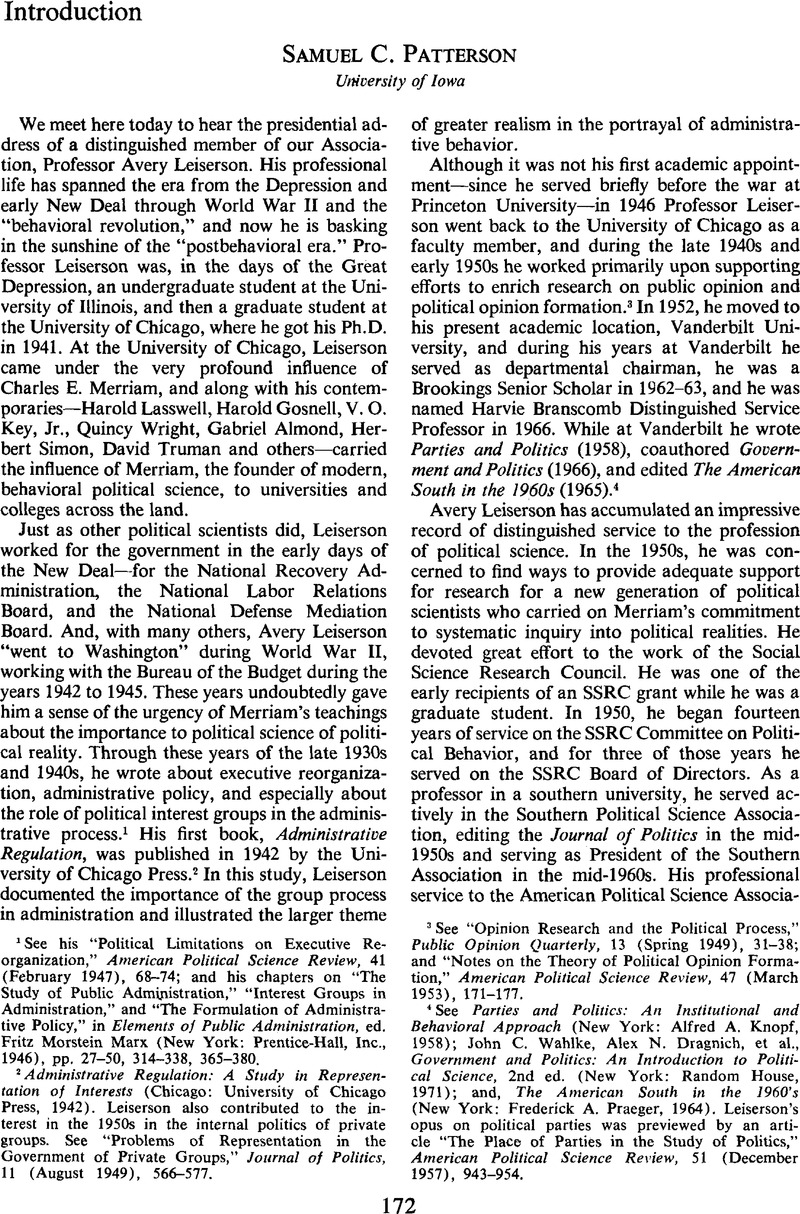No CrossRef data available.
Published online by Cambridge University Press: 01 August 2014

1 See his “Political Limitations on Executive Reorganization,” American Political Science Review, 41 (February 1947), 68–74CrossRefGoogle Scholar; and his chapters on “The Study of Public Administration,” “Interest Groups in Administration,” and “The Formulation of Administrative Policy,” in Elements of Public Administration, ed. Marx, Fritz Morstein (New York: Prentice-Hall, Inc., 1946), pp. 27–50, 314–338, 365–380Google Scholar.
2 Administrative Regulation: A Study in Representation of Interests (Chicago: University of Chicago Press, 1942)Google Scholar. Leiserson also contributed to the interest in the 1950s in the internal politics of private groups. See “Problems of Representation in the Government of Private Groups,” Journal of Politics, 11 (August 1949), 566–577CrossRefGoogle Scholar.
3 See “Opinion Research and the Political Process,” Public Opinion Quarterly, 13 (Spring 1949), 31–38CrossRefGoogle Scholar; and “Notes on the Theory of Political Opinion Formation,” American Political Science Review, 47 (March 1953), 171–177CrossRefGoogle Scholar.
4 See Parties and Politics: An Institutional and Behavioral Approach (New York: Alfred A. Knopf, 1958)Google Scholar; Wahlke, John C., Dragnich, Alex N., et al., Government and Politics: An Introduction to Political Science, 2nd ed. (New York: Random House, 1971)Google Scholar; and, The American South in the 1960's (New York: Frederick A. Praeger, 1964)Google Scholar. Leiserson's opus on political parties was previewed by an article “The Place of Parties in the Study of Politics,” American Political Science Review, 51 (December 1957), 943–954CrossRefGoogle Scholar.
5 Reprinted in Political Behavior: A Reader in Theory and Research, ed. Eulau, Heinz, Eldersveld, Samuel J., and Janowitz, Morris (Glencoe, Ill.: Free Press, 1956), pp. 53–64Google Scholar [from Political Science Quarterly, 68 (December 1953), 558–584]CrossRefGoogle Scholar.
6 Ibid., p. 56.
7 See “Empirical Approaches to Democratic Theory,” in Political Research and Political Theory, ed. Garceau, Oliver (Cambridge: Harvard University Press, 1968), pp. 13–38CrossRefGoogle Scholar.
8 Leiserson concerned himself with political analysis of the scientific establishment and science policy in “Scientists and the Policy Process,” American Political Science Review, 59 (June 1965), 408–416CrossRefGoogle Scholar. His presidential address to the Southern Political Science Association was devoted to “Science and the Public Life,” Journal of Politics, 29 (May 1967), 241–260CrossRefGoogle Scholar.
9 Parties and Politics, p. 355.
10 In addition to writings already mentioned, see “National Party Organization and Congressional Districts,” Western Political Quarterly, 16 (September 1963), 633–649CrossRefGoogle Scholar.
11 “The Changing South: Some Social Science Applications,” in Perspectives on the South: Agenda for Research, ed. Thompson, Edgar T. (Durham, N. C.: Duke University Press, 1967), pp. 3–16Google Scholar; quoted at p. 14.
12 See “Realism and Commitment in Political Theory,” in The Post-Behavioral Era: Perspectives on Political Science, ed. Graham, George J. Jr. and Carey, George W. (New York: David McKay Cornpany, Inc., 1972), pp. 144–170Google Scholar; quoted at pp. 144–145.
Comments
No Comments have been published for this article.